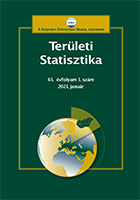Egyes hazai helyi pénzek (forgatható utalványok) elfogadóhelyeinek térbeli elemzése
Spatial analysis of selected domestic local currencies
(negotiable voucher)
Author(s): József Varga, Róbert Barna, Bernadett Horváthné KovácsSubject(s): Social Sciences, Economy, Geography, Regional studies
Published by: Központi Statisztikai Hivatal
Keywords: alternative financial means; local currency; spatial distribution; spatial autocorrelation
Summary/Abstract: The second decade of the 21st century maybe considered the childhood of local currencies in Hungary. The use of five Hungarian local currencies (negotiable vouchers) starting with the issuance of Sopron Kékfrank in2010 has brought up such „children’s diseases” which may serve as a lesson to be learned for future local currencies. The first part considers the macroeconomic embeddedness of a local currency, while the second part examines the micro economic aspects of the relation of local product – local currency in the cases of Kékfrank of Sopron, Bocskai Korona of Hajdúnánás, which are the oldest and most successful lo cal currencies and the Balatoni Korona. Our study analyzes the use of local currencies as alternative financial systems more than 10 years after the 2008 global economic crisis. The basic hypothesis of the analyses is that localisation of finances along with the localisation of the area’s real economy may be found in the spatial patterns of the utilization of the alternative financial means, too. In the chosen cases of local currencies, the spatial distribution of issuers and acceptors at settlement level, the number and concentration of acceptors and the heterogeneity and clusterisation in the accepting area have been studied with the use of spatial autocorrelation indicator.It has been found that the majority of accepting places are in a very concentrated area (around the issuer), some further acceptors may be found in the middle zone, and between a 40-80 kilometers distance the number of accepting places increases again. This spatial distribution does not follow the one of a typical local product.
Journal: Területi Statisztika
- Issue Year: 62/2022
- Issue No: 04
- Page Range: 435-455
- Page Count: 21
- Language: Hungarian

